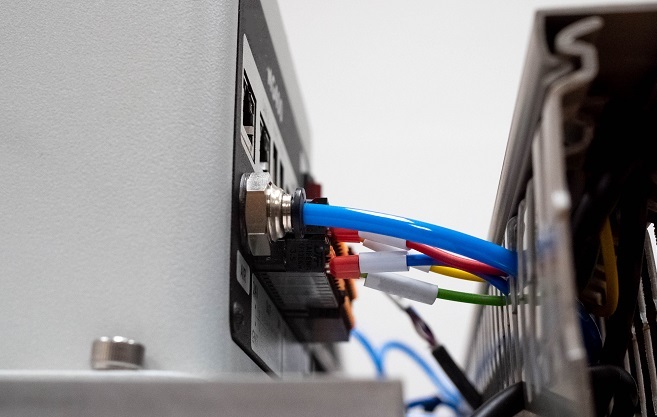
 Data Structure
Data Structure Networking
Networking RDBMS
RDBMS Operating System
Operating System Java
Java MS Excel
MS Excel iOS
iOS HTML
HTML CSS
CSS Android
Android Python
Python C Programming
C Programming C++
C++ C#
C# MongoDB
MongoDB MySQL
MySQL Javascript
Javascript PHP
PHPPhysics
Chemistry
Biology
Mathematics
English
Economics
Psychology
Social Studies
Fashion Studies
Legal Studies
- Selected Reading
- UPSC IAS Exams Notes
- Developer's Best Practices
- Questions and Answers
- Effective Resume Writing
- HR Interview Questions
- Computer Glossary
- Who is Who
What is the full form of DLCI?
Definition of DLCI
Data Link Connection Identifier (DLCI) is a ten-bit identifier utilised in frame Relay networks to discover a specific virtual circuit (VC) within a body Relay community. DLCI is used to differentiate between one of a kind statistics connections at the equal physical circuit by assigning every connection a unique identifier.

DLCI values are locally huge, that means that they handiest have which means to the body Relay equipment on both stops of the relationship. The DLCI value is used by the body Relay switch to perceive which VC the incoming body belongs to, and then forward it to the precise destination.
Function of DLCI
The data link Connection Identifier (DLCI) serves several functions in a frame Relay community −
Figuring out virtual circuits − DLCI is used uniquely to identify every virtual circuit (VC) in a frame Relay community. Each DLCI price is assigned to a specific VC, permitting multiple VCs to be multiplexed over a single physical circuit
Supplying addressing statistics − while a frame Relay switch gets a body, it makes use of the DLCI cost to determine which VC the body belongs to and forwards it to an appropriate destination.
Multiplexing − DLCI values are used to multiplex a couple of VCs over a single circuit. By assigning each VC a completely unique DLCI cost, more than one connection can proportion the same circuit without interfering with every difference.
Congestion Control − DLCI values may be used to prioritise positive VCs over others for the duration of durations of congestion. Frame Relay switches can be configured to provide higher priority to frames with sure DLCI values, making sure that crucial information is transmitted with minimum put off.
DLCI Format
The data link Connection Identifier (DLCI) format is a 10-bit binary number used to discover a virtual circuit (VC) in a frame Relay network. The DLCI is part of the frame header and appears among the address field and the manage field.
The format of the DLCI is as follows −
DLCI |
C/R |
EA |
DLCI |
FECN |
BECN |
DE |
EA |
|---|---|---|---|---|---|---|---|
8 7 6 5 4 3 |
2 |
1 |
8 7 6 5 |
4 |
3 |
2 |
1 |
Description: Header format of Frame Relay
The first six bits constitute the DLCI cost, ranging from zero to 1023. However, certain DLCI values can be reserved for precise functions.
The seventh bit is the Command/response (C/R) bit, that's used to indicate whether the body is a command or a response. In exercise, this bit is regularly set to 0, indicating a command frame.
The 8th bit is the forward express Congestion Notification (FECN) bit, that is used to inform the receiving tool of congestion within the community. while set to 1, it suggests that congestion has been experienced within the ahead route.

The 9th bit is the Backward specific Congestion Notification (BECN) bit, that is used to notify the sending tool of congestion inside the community. whilst set to one, it shows that congestion has been skilled inside the backward course.
The 10th bit is always set to zero and is reserved for future use.
In summary, the DLCI layout is a 10-bit binary number that identifies a virtual circuit in a body Relay community and presents additional information approximately the body, inclusive of its path and congestion repute.
DLCI and Frame Relay
The data link Connection Identifier (DLCI) is a unique identifier used in body Relay networks to pick out digital circuits (VCs). Frame Relay is a Layer 2 protocol that is used to transmit data over huge region Networks (WANs) using excessive-pace connections. The protocol makes use of a DLCI to distinguish between more than one VCs that may be established over a single physical connection.
In frame Relay networks, every tool is attached to a body Relay switch, and each connection among devices is represented by means of a VC. Each VC is assigned a completely unique DLCI, that's used to pick out the VC and path frames to the best destination. While a frame arrives at a body Relay switch, the transfer uses the DLCI to decide which VC the body belongs to and forwards the body to the right vacation spot device.
DLCI values are domestically tremendous, meaning that they are handiest meaningful to the devices on both ends of the connection. Consequently, distinct connections between one-of-a-kind devices can use the equal DLCI values, so long as the connections do not overlap. DLCI values also are used for congestion manipulation, where positive DLCIs may be given better precedence than others to make sure that crucial statistics are transmitted with minimum postponement.
Conclusion
DLCI is a important parameter used in body Relay networks to establish connections between gadgets, become aware of virtual circuits, and route frames to their accurate vacation spot. by using particular DLCI values, more than one VCs may be multiplexed over a single connection, making an allowance for green use of network sources.DLCI is an essential parameter utilised in frame Relay networks to set up communique between community gadgets and make certain efficient use of network sources.
FAQS
Q1. Can DLCIs be reused or shared between multiple connections
Ans: Yes, DLCIs can be reused or shared between more than one connection in frame Relay networks. This is possible due to the fact that DLCIs are locally great and are most effectively used to identify a selected digital circuit between two devices within the community. so long as the DLCI is specific inside a given body Relay network, it can be used to become aware of one of a kind virtual circuits between special pairs of gadgets.
Q2. How are DLCIs assigned and managed in modern networking environments
Ans: In contemporary networking environments, DLCIs are usually assigned and controlled the usage of a selection of gear and strategies like guide configuration, Dynamic allocation, network control software and Automation gear.
Q3. What tools or techniques are used to monitor and troubleshoot DLCI-related issues
Ans: Many network monitoring equipment may be configured to track overall performance metrics for character digital circuits recognized via DLCIs. This will help to identify troubles with congestion, packet loss, or different problems that may be affecting community overall performance.

